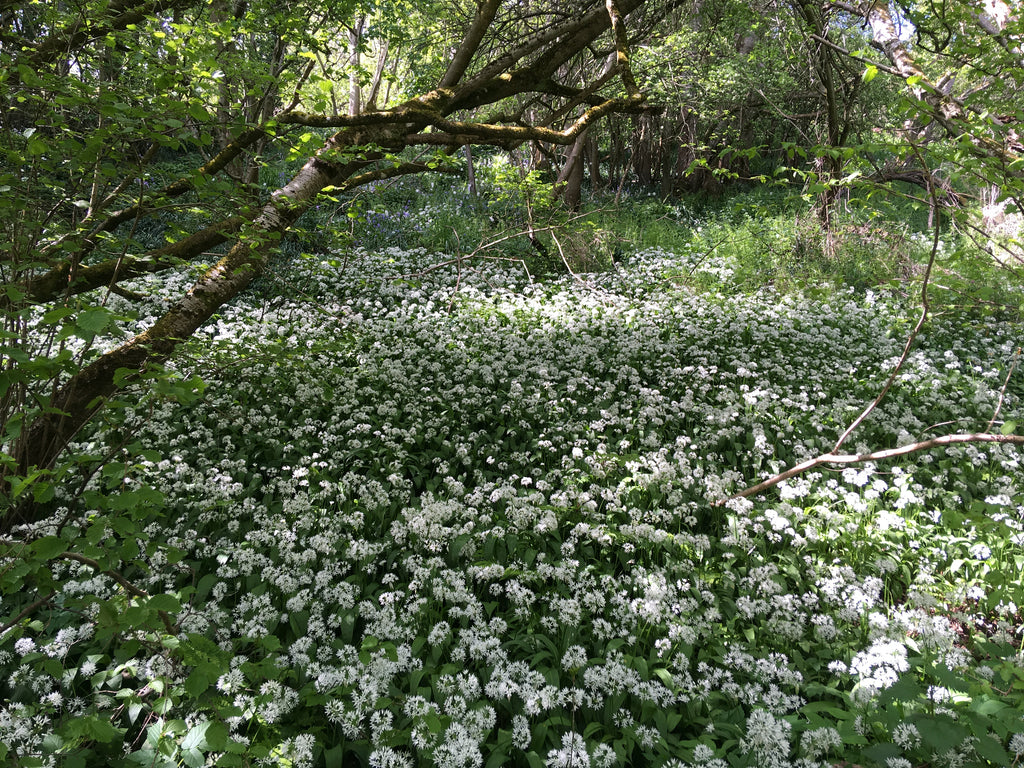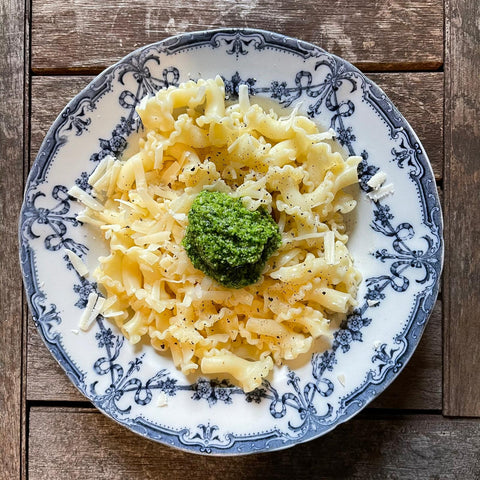
If you’ve ever stepped into a woodland in spring and smelled a strong, onion-like scent, you’ve almost certainly stumbled across a patch of wild garlic. Also known as ramsons, this pungent plant is utterly delicious, and can be added to soups, scones, and pasta recipes in the form of wild garlic pesto. Read on to learn more, and for our recipes for cheese and wild garlic scones, and wild garlic pesto!
What is wild garlic?

As its name suggests, wild garlic is a wild relative of onion, garlic, and other alliums. It’s native to Europe and Asia, and can be found in shady, damp woodlands from late winter through to June, often forming an abundant carpet of leaves. It has a lighter taste than garlic which can be affected by heat, so it’s best to add it to dishes towards the end of cooking.
How to identify wild garlic (and avoid poisonous plants!)
Although its leaves have the most flavour while young, if you’re new to foraging you might wish to wait until the plant flowers before collecting it, to avoid mistaking it for Lily of the Valley, which is poisonous! The easiest way to differentiate the two plants is by their scent, as Lily of the Valley does not have the onion-like smell of wild garlic. Once the plant flowers, wild garlic has star-shaped flowers on a spherical, globe-like head (see photo below):

Lily of the Valley, however, has bell-shaped flowers grouped together in clusters on one side of the stem (see photo below):

Another poisonous plant that can sometimes be mistaken for wild garlic is autumn crocus, which flowers later in the year, and can be mistaken for wild garlic before it does. If in doubt, always err on the side of caution!
Which parts of the plant can I pick?
When foraging, it’s important to bear in mind that it is illegal to dig up or uproot plants unless they are on your own private land, so only pick the plant from the ground upwards. Try to be considerate towards other foragers and wildlife, too, and avoid taking too much from one area. All parts of the plant are edible, including the stems, leaves, and flowers, which look beautiful in salads or as a garnish for soups and other dishes.

You might wish to pick leaves away from the edges of paths, to avoid anything left behind by canine visitors! In areas of dense growth it’s a good idea to pick slowly and carefully, leaf by leaf, so as not to accidentally gather any other plants that often grow alongside wild garlic, and might not be edible. Once home, thoroughly rinse your harvest under cold water - I find a salad spinner particularly useful for drying the leaves afterwards!
Relatives to wild garlic

If you struggle to find wild garlic near you, you might perhaps discover an alternative, such as few-flowered leek, another edible plant which is closely related to wild garlic, and also has an onion-like smell, but with narrower leaves. As an invasive species, it’s illegal to encourage the spread of few-flowered leek, meaning that you’re essentially performing a civic duty if you eat it instead! Few-flowered leek has small white drooping flowers, and bulbils, which you can see in the photo above. Again, it’s important not to mistake it for pre-flowering snowdrops, bluebells, daffodils, or crocus, all of which are toxic, but do not share its onion-like smell.
Our favourite wild garlic recipes
Cheese and wild garlic scones

Wild garlic be added to recipes anywhere that might use chives, including in salads and these delicious cheese scones! (Recipe adapted from this BBC Good Food Recipe.)
Ingredients
- 225g self-raising flour
- A pinch of salt
- A pinch of cayenne pepper
- 1 tsp baking powder
- 55g chilled butter, cut into cubes
- 120g mature cheddar cheese, grated
- 90-100ml milk, plus 1 tbsp for glazing
- A handful of chopped wild garlic
Method
1: Pre-heat the oven to 200C/180C fan/gas 6 with a large baking tray inside.
2: Sift the flour, salt, cayenne pepper and baking powder into a bowl, then sift again to make sure the ingredients are thoroughly combined.
3: Add the butter to the bowl and combine with your fingertips to make breadcrumbs.
4: Sprinkle 100g of the cheese, and chopped wild garlic, into the breadcrumb mixture and rub together until evenly distributed. Try not to mix too much as the heat from your hands may start to melt the butter.
5: Make a well in the centre of the mixture and pour in enough milk to give a fairly soft but firm dough. Do not pour in all the milk at once as you may not need it all to get the right consistency.
6: Lightly flour a surface and roll out the dough to approximately 2cm thick.

7: Cut out the scones with a medium (about 8cm) cutter.

8: Place on a sheet of baking parchment, glaze with a little milk and sprinkle with the remaining cheese. Slide onto the hot oven tray.

9: Bake in the oven for 15-20 mins or until golden brown and cooked through, and enjoy with butter while still warm!

Wild Garlic Pesto

One of our favourite ways to use wild garlic is in a pesto, which can be served with pasta (it’s particularly delicious with spicy Italian sausages!), on roast potatoes after they’re removed from the oven, or even on oatcakes! Ideally you’ll need a food processor or hand blender to make this, but you could get by using an old-fashioned pestle and mortar, or by finely chopping the wild garlic leaves and crushing the nuts in a sandwich bag using a rolling pin!
Ingredients
- A large bunch of wild garlic leaves (around 150g)
- A handful of nuts (around 150g) - hazelnuts and cashews are particularly delicious, but you can experiment with what you have in the cupboard!
- 150ml oil - rapeseed has a mild flavour that doesn’t overpower the garlic, but you can also use olive oil
- A good handful of grated Parmesan cheese (around 50g), or use nutritional yeast for a vegan version

Method
If using a food processor, begin by processing the nuts until finely chopped. After thoroughly washing your wild garlic leaves, add them to the processor along with the oil, and blend for a few moments until smooth. Add in the grated Parmesan or nutritional yeast at the end, and mix until combined.
If using a hand blender, add the nuts and as much of the wild garlic as you can to a tall pot, plus a little of the oil. Blend, and gradually add in more leaves and oil as you go, until you have a smooth consistency. Add the grated Parmesan at the end, mixing it in with a spoon.
Eat immediately, or store in a sterilised jar in the fridge for around a week!
We hope you've enjoyed learning more about wild garlic! If you do make your own scones or wild garlic pesto, we'd love to see your photos of them! Please share them with us on Facebook, Instagram, Pinterest, & Twitter!
Enjoying our blog posts? Join our mailing list to receive every new post straight to your inbox!
At The Crafty Kit Company we hate spam, we never share data and you can unsubscribe from our mailing list at any time.

Comments
Rebecca:
So glad you enjoyed the blog Lara – and thank you for the great tip! Will definitely have to give that a go! xx
Apr 19, 2021
Lara Butler:
This is a fantastic blog you can also pickle the seeds and make them into tiny garlicky capers they are Devine!
Apr 19, 2021
Leave a comment